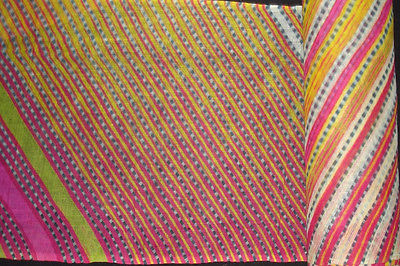LEHERIA – INDIAN HANDWORK (‘TIE & DYE’ METHOD - MULTICOLORED)
Meaning:
‘Leheria’ is a conventional dyeing style by which enticing designs like diagonal bands and wave motifs are created. 'Leher' in Hindi stands for 'wave' and ‘Leheria’ is a derivative of this expression.

History:
The Indian State of ‘Rajasthan’ is the center of this dyeing (tie & dye) method. The ‘Marvari’ business class and the native retailers of the 19th and the initial period of the 20th centuries supported ‘Leheria’, because, they had the habit of wearing gaudy ‘turbans’ which were made using this special work.
During the initial days, ‘red’ and ‘yellow’ color dyes were used for ‘Leheria’ creation, since they were considered as propitious colors. Even today such ‘Leheria’ material is well accepted in some places of Rajasthan such as ‘Nathdwara’, ‘Jodhpur’, and ‘Udaipur’. In addition to this stuff, there was also a special ‘Leheria’ (termed as ‘Panchranga’), and this was created using five different colors. Wearing leheria was regarded as most favorable during religious and also while attending special functions.
Leheria technique:
‘Resist Dyeing’, the unique method of dyeing is applied for creating ‘Leheria’. The material is reeled in a crosswise manner first; after that, knots are made at fixed distances and dyed. Soon after this process, the dyed material (before drying and with the dampness of the dye) is fastened to a rod made of wood. The process is continued with lighter pigments and again with the darker ones. The reeled material is unlocked at certain parts, while the other portions are kept intact for making motley ‘Leheria’. New knots are made and the entire piece is dyed using the desired dyes.

Recognizing Leheria:
The attractive strip designs that are created in a crosswise manner using dark shades are the key distinguishing marks of ‘Leheria’. Generally, the fine texture varieties of ‘chiffon’, ‘cotton’, ‘silks’, and ‘voil’ are used as the base cloth, because, they will facilitate the diffusion of dyes. ‘Leheria’ is customarily used to make ‘dupattas’, ‘sarees’, and men’s ‘turbans’.
‘Salaidar’ is the special type ‘Leheria’, and there will be banded designs in this.

Salaidar Leheria
Crisscross design is a difficult one to create; here the four pleats are made into the form of a wave, which is generally termed as ‘Gandadar’.

You can identify ‘Leheria’ by taking note of the banded designs. In printed ‘Leheria’ the bands (stripes) will look proportioned; however, when ‘tie & dye’ method is applied, the stripes will be somewhat unsymmetrical, which of course is prevalent in manual work.
Visit Sanskriti website; you can very clearly see the leheria pattern and the close range images of ‘Leheria’.


Leheria types:
Basically, ‘Leheria’ is classified into four distinctive groups.
Pasavalli Leheria:

In this brand, the designs will be of waves and on inverse tracks, thus creating the image of a broken ‘Leheria’. The base cloth is reeled and knotted at certain parts and dyed. The primary dyeing will be done using pastel colors; the process is repeated using dark dyes and by applying the same ‘tie & dye’ method, but from the inverse tracks.
Mothra Leheria:

In this model, ‘tie & dye’ method is applied to create a typical plaid pattern that looks alluring.
Samunder Laher Leheria:

‘Samunder Laher’ is a Hindi phrase and the meaning is 'Waves of Ocean'. The typical trait of this brand ‘Leheria’ is that, light dyes which are similar to ocean water such as ‘Sea Green’, ‘Pale Yellow’, ‘Blue’, ‘Pastel Green’, etc are used for dyeing. There will be crosswise bands of identical width.
Bhopalshahi Leheria:

Here the design will be in a crisscross manner. Numerous pleats are created first and are reeled crosswise; this will create a crisscross design.
Interesting Facts:
-
‘Leheria’ is named in accordance with the use of dyes; in 'Dho Ranga Laheriya', two different dyes are used, there will be three different dyes in ‘Teen Ranga Leheria’, and for creating ‘Panch Ranga Leheria’, five different dyes are used.
-
‘Patta’ is the ‘wide’ strip in ‘Leheria’ and ‘Shike’ is the ‘thin’ strip.
-
‘Panyla’ is motley ‘Leheria’ and in ‘Rajasahi Leheria’ there will be only one color.
- .


